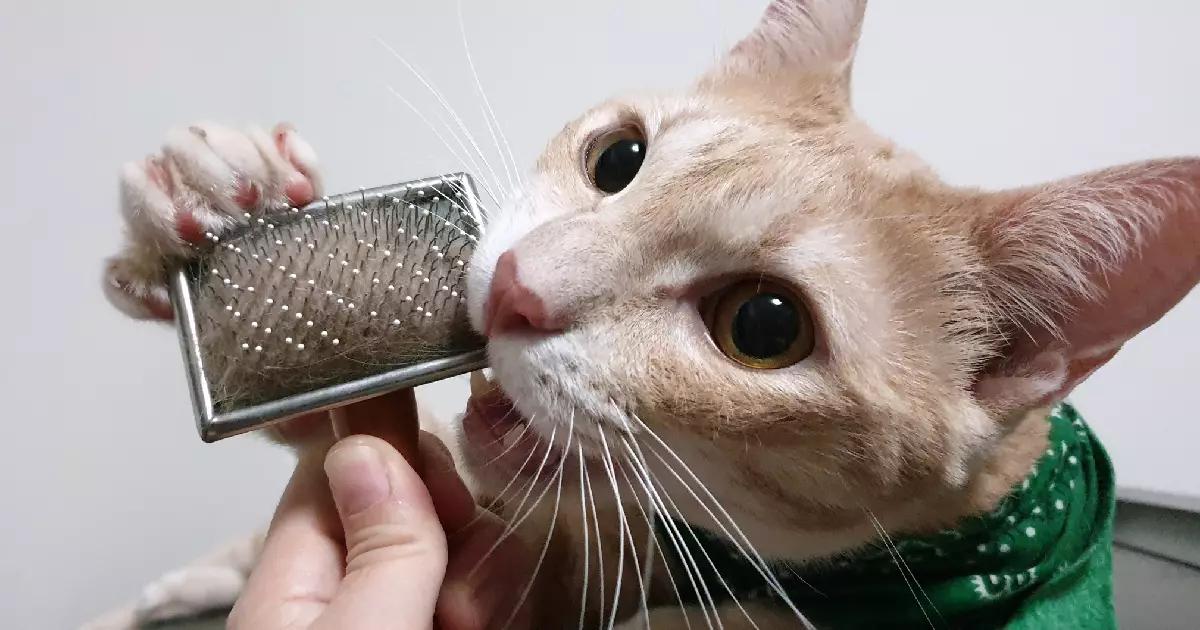Cats are often seen as the epitome of elegance and poise, spending a significant portion of their day meticulously grooming themselves. This fastidious behavior isn’t merely for aesthetics; it serves several crucial purposes for our feline companions. Primarily, grooming helps to remove loose fur, dirt, and parasites from their coats. It’s not just a self-care ritual; it’s a survival tactic woven into their instincts. However, this habitual licking can lead to a curious yet concerning phenomenon: the consumption of hair.
Imagine the scene: you’re relaxing in your living room when your cherished kitty unexpectedly pounces on a tuft of fur that you had just brushed off the couch. Moments later, they chew and swallow it as if it were their favorite treat. It’s repulsive and perplexing, evoking uncertainty over whether your pet is indeed indulging in a peculiar snack or if something deeper lurks beneath the surface of this bizarre behavior.
Cleaning Up the Evidence
For many cats, the compulsion to eat their shed fur is an instinctual response rooted in their ancestral behavior. In the wild, a cat must maintain its hygiene to avoid detection by predators or rivals. Eating fur that has been shed might seem unusual to us, but it could serve an evolutionary purpose. By consuming their hair, cats might be trying to eliminate any scents that could betray their location in the wild.
Moreover, when noticed by their humans, some cats may perceive this act as an opportunity to maintain an organized and “safe” space. For cats, tidiness represents a form of self-care, where eating their own fur becomes the ultimate embodiment of control over their environment. It’s an instinctive behavioral pattern that aligns with their natural tendencies, reminding us that as much as we try to anthropomorphize them, they still carry a different worldview.
The Role of Boredom and Exploration
On the other hand, cats are renowned for their curious and playful personalities, leading them to engage in eccentric behaviors simply due to boredom. If your cat is consuming tufts of hair off the floor, it might be a manifestation of their need for mental stimulation or play. Cats often use their mouths to explore their environment, much like humans use their hands. Sometimes, what appears to us as peculiar behavior is merely a cat’s attempt to interact with their surroundings.
To mitigate boredom-related behaviors, it is critical to provide sufficient playtime and engaging toys that stimulate your cat’s innate hunting instincts. Without proper environmental enrichment, a cat may resort to munching on non-food items as a form of self-entertainment. A resource-rich environment where they can climb, scratch, and explore can help redirect these potential behavioral issues.
Health and Nutritional Considerations
Alongside instinct and boredom, another layer to this fur-eating behavior lies within health considerations. In some instances, a cat might chew on their fur or that of their companions due to nutritional deficiencies. This condition, medically termed pica, can signal underlying health problems that merit attention. Cats may indulge in non-food items, including fur, in an attempt to fulfill something missing in their diet.
If your cat’s penchant for munching on fur turns into a compulsive habit or is accompanied by changes in appetite or behavior, it’s time to consult with a veterinarian. They can provide insights into possible health issues that could affect digestion or overall well-being, addressing nutritional deficiencies by tailoring their diet or assessing gastrointestinal concerns.
Stress and Anxiety Behaviors
Emotional well-being is equally important. Just as humans turn to unhealthy habits during stressful times, cats might engage in excessive grooming or fur consumption when faced with anxiety. Changes in environment, routine, or even family dynamics can unsettle cats, prompting irrational behaviors. If you notice that your feline friend starts eating more fur coinciding with stressors, it may be time to reevaluate their surroundings and consider methods to reduce anxiety.
Observing subtle cues in your cat’s behavior can provide vital insights. Whether it’s excessive grooming, lethargy, or hiding, consulting with a veterinarian can help identify the best approach to alleviate your cat’s unease.
The Bottom Line of Feline Fur Feasting
While the sight of your cat munching on fur might elicit a chuckle or a cringe, it reflects a fascinating intersection of instinct, health, and environmental factors. As devoted caretakers of these purring enigmas, it falls upon us to ensure that they lead happy, healthy lives filled with stimulation, comfort, and love. Your role is crucial: stay observant, provide for their needs, and remember that each whisker-twitching moment of their life is a beautiful combination of instinct and indulgence. So as they munch on that tuft of fur, recognize that beneath their idiosyncratic ways lies the ancient essence and need for survival.


Leave a Reply